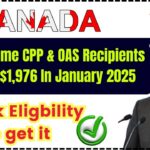$2,200 + $4,200 Stimulus Boost Coming In January 2025: The buzz about a $2,200 + $4,200 stimulus boost has caught the attention of millions. If you’re wondering whether this applies to you and what steps to take next, you’re in the right place. This article will break it down in simple terms, providing practical advice, clear examples, and actionable insights to help you understand your eligibility and what to expect. This guide is designed to be your comprehensive resource on the subject.

$2,200 + $4,200 Stimulus Boost Coming In January 2025
| Feature | Details |
|---|---|
| Program Name | Federal and State Stimulus Programs |
| Maximum Payment | $2,200 (federal boost) + $4,200 (state-specific programs) |
| Eligibility Criteria | Income thresholds, tax filings, dependents, and state residency requirements |
| Payment Dates | Federal: January 15, 2025; State: Varies by state (check official websites for updates) |
| Official Resource Link | IRS Official Stimulus Page |
| Additional Support | Social Security COLA increase, child tax credits, and other relief measures |
The $2,200 + $4,200 stimulus boost offers a valuable opportunity for eligible individuals and families to start the new year with financial relief. By understanding the eligibility requirements, filing your taxes on time, and staying informed about state-specific programs, you can maximize your benefits. Remember to use official resources and consult financial advisors if needed.
Understanding the Stimulus Boost
To start, let’s break down the two components of this stimulus:
- $2,200 Federal Stimulus: This boost stems from federal economic relief aimed at supporting families and individuals facing inflationary pressures. It is intended to help offset rising costs and provide a financial cushion.
- $4,200 State-Specific Programs: Certain states are rolling out additional stimulus checks or tax rebates to their residents. The amounts and criteria vary widely, based on local needs and state budgets. These programs often target specific groups, such as low-income households or essential workers.
Together, these benefits could add up to $6,400 for eligible individuals and families—a significant financial lifeline to help with the rising cost of living as the year begins.
Who Is Eligible for the Federal $2,200 Boost?
To qualify for the federal stimulus, you need to meet specific requirements. These criteria ensure that the funds are distributed equitably to those who need them most.
1. Income Thresholds
- Individuals: Earn less than $75,000 annually.
- Married Couples Filing Jointly: Combined income under $150,000.
Example: If you’re single and make $60,000 a year, you qualify. If you’re part of a married couple earning $140,000 jointly, you’re also eligible. Higher income brackets may receive reduced payments based on a sliding scale.
2. Filing a 2024 Tax Return
Your eligibility is tied to your 2024 tax return. Ensure you’ve filed on time and accurately reflect your income, filing status, and dependent information. Inaccuracies could delay your payment or reduce the amount.
3. Dependents
Parents or guardians can receive additional funds for dependents under 17 years old. For example, a single parent earning $50,000 with two kids might receive an extra $1,400 per child, significantly increasing their total benefit.
4. Other Special Cases
Non-tax filers, Social Security recipients, and individuals on disability benefits may also qualify for payments if they meet other eligibility criteria.
What About the $4,200 State Stimulus?
State programs vary widely, but here are some examples of how these programs work and whom they are designed to support:
California
California’s Middle-Class Tax Refund provides payments of up to $1,050 for eligible residents. These programs aim to address the rising cost of living, including housing and energy expenses. Similar initiatives may continue into 2025.
Florida
Florida has focused on bonuses for essential workers, such as teachers, nurses, and first responders. In 2024, payments ranged from $1,000 to $4,200, depending on the role and qualifications. New programs may expand eligibility to include additional professions.
New York
New York’s Property Tax Rebate Program offers payments to homeowners meeting income and residency requirements. The program also targets renters with credits to help offset rising rental costs.
Other States
States such as Texas, Pennsylvania, and Illinois have introduced or are considering similar programs. These often address energy relief, housing affordability, and other local challenges.
Check your state’s official government website for updates and tools to verify your eligibility.
How to Check Your Eligibility for $2,200 + $4,200 Stimulus Boost
Not sure if you qualify? Follow these steps to determine your eligibility for both federal and state programs:
Step 1: Review Income Levels
Verify your adjusted gross income (AGI) from your latest tax return. If it falls below the required thresholds, you’re likely eligible. Use online tax calculators to estimate your AGI if needed.
Step 2: Check Residency
For state-specific programs, ensure you’ve met residency requirements, which typically involve living in the state for at least six months. Some programs may have additional requirements, such as proof of rent or property ownership.
Step 3: Use Online Tools
Many states and the IRS offer online calculators and pre-screening tools to estimate your potential payment. These tools can provide instant feedback based on your income, family size, and residency status.
Step 4: File Your Taxes Early
Submitting your tax return early ensures timely processing of your payment. Missing deadlines can delay your benefits or disqualify you altogether. Tax preparation services can help ensure accuracy and completeness.
Step 5: Stay Informed
Sign up for updates from the IRS or your state’s tax authority. Changes in legislation or funding could impact your eligibility.
Payment Timeline
Here’s when you can expect the payments:
- Federal Stimulus ($2,200): Scheduled for January 15, 2025. Ensure your direct deposit information is updated with the IRS to avoid delays.
- State Payments ($4,200): Varies. Some states distribute payments in monthly installments, while others issue lump sums. Check your state’s schedule for details.
Tip: Direct deposit is the fastest and most secure way to receive your payment. Make sure your bank information is accurate and up to date.
$1,300 Monthly Cut in Social Security Checks – Check Date & Eligibility
Social Security is About to Change: New US Retirement Age Proposed
2 Direct Deposit Checks Under Trump 2.0 In January 2025 – Check Facts
FAQs About $2,200 + $4,200 Stimulus Boost Coming In January 2025
1. Can I receive both the federal and state payments?
Yes, if you meet the eligibility criteria for both. For example, a Florida resident who qualifies for the federal $2,200 and a $4,200 state bonus could receive the full $6,400.
2. What happens if I miss the tax-filing deadline?
You can still claim the payment through the Recovery Rebate Credit when you file your taxes later, but delays are likely. Filing extensions may be available in some cases.
3. Are Social Security recipients eligible?
Yes, Social Security beneficiaries often qualify, provided they meet income thresholds and other criteria. Payments may be automatic for some beneficiaries.
4. How do I avoid scams?
Only rely on official websites, such as irs.gov or your state’s government site, for information. Avoid sharing personal details over the phone or via email with unverified sources.
5. Are there other relief programs I can explore?
Yes, additional support may be available through child tax credits, housing assistance programs, or utility relief funds. Contact your local government for more details.








